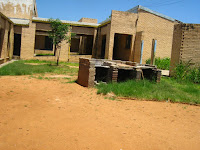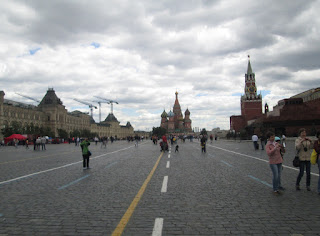The dogs and I shared the Sunday Sibebe morning
walk with someone else.
By rights we should not have been walking
together because the organized walk planned for the previous day had been
called off due to expected inclement weather. Had that walk gone ahead the boys
would have been excluded (society rules) and been left at home cooling their
heals.
As it happened the morning beamed at me with
clear blue skies and yesterday's rain sodden clouds kept their early morning
distance over the mountains to the West, although by doing so did not exclude a
return of their wet and windy behavior over the past three days. By nine
o'clock - a late start I readily admit - the day was warming, the sun gently
combating the light wind that was still carrying the memory of a night chill.
I decided to walk North along the base of the
rocks rather than bounding straight up the Zip, partly because although the
granite on the steep slope of the Zip is rough, after rain even the course
grained surface is treacherous. I also felt that my Sunday morning body was not
ready for any form of bounding. A more steady ascent was somehow more seemly.
Importantly I also wanted the visit the painted
man, to photograph him and record his GPS location.
Once over the annoyingly un-ergonomic stile that
straddles the barbed wire fence by means of two ungainly horizontal poles we
climbed through an isolated stand of last seasons knee high grass which had
escaped recent Veldt fires, up to the higher pastures that had been burnt off.
 |
| HIgh Veldt pastures that have recently been burnt off |
 |
| A cosy rock overhang |
One of the dogs set up a game bird, I think a
Francolin, which rose with an alarmed shriek and flew in noisy indignation at a
low trajectory downhill away from us. I wonder why ground breeding birds always
fly downhill when disturbed and never up the mountain?
The painted man stands alone in a cosy rock
overhang. He stands about 5 inches high on a concave rock face about 2 feet
from the earth floor. Why he is there I cannot tell. Why he is alone I also
cannot tell, and indeed I cannot be sure of its gender. Perversely I suspect a
male because there is no indication that it is a female. And I also have no
idea how long he has been standing there. The "pre-history" of this
area, and by that I mean the history that pre-dates European written records
and Swazi oral records, is, by its very nature, contested ground and
archaeological dating of such signs is open to conjecture.
 |
| The Painted Man |
We leave the rock shelter and climb upwards
through boulders and stunted protea bushes. The ground is red where cattle and
humans have exposed the friable sub-soil. Here the 'A' soil horizon is thin and
fragile, and once the sparse vegetation cover is damaged or removed erosion
advances rapidly. Once out of this series of minor gullies and up a steep sheet
of rock the vegetation on the higher, steeper slopes is thinner, but the
diversity of new spring flower growth is more evident. High Veldt ground-cover
is sparse and fragile, there is not the degree of root reinforcement of lower
and flatter areas, but perhaps because of that the profusion of young colour
and growth is striking. And this is the season of the Coral Tree (Erythrina zeyheri) which flourishes stark and showy, bright red sprays on otherwise denuded, leafless branches.
 |
| Coral Tree (Erythrina zeyheri) |
The author of the painted man, the artist of
pre-history would also have followed this path, and at this time of year, after
heavy early rains would have seen these same growths; there is no
obvious recent infestation of alien vegetation in this area. I wonder what they would have meant to
him or her?
I share this landscape with the painted man,
through the eyes of the artist of the painted man who many years ago also
traversed this land but who walked this mountain for very different reasons.
Who looked with eyes and senses alert for the swift and furtive movement of
small game who are equally alert for potential predators. Who walked with
knowledge and purpose towards areas where herbs, fruits and rhizomes were known
to grow, to harvest them for whatever small community she belonged to. Who
perhaps walked with feelings of fear of the spirits and deities that controlled and directed how this land
behaves.
The painted man and the artist are one in my eye
and in my spirit, because they are indivisibly one, a representative of a group who shared this
landscape long ago - and are sharing it now, with me.
Having laboured through small gullies and up
slabs of exposed granite we top the initial edge of the mountains to arrive at
new lush High Veldt pasture, pristine light greens of new spring growth
following recent fires, spotted and splashed with dashes of blues, yellows and
reds.
As we lope across this gentle relieving highland
I feel suddenly vulnerable; alone and exposed and strangely fearful of a
lightening struck death. Although there are and have been neither indications
of lightening and thunder, nor that indefinable sense of primordial electricity in
the air I quicken my step and look back and around me. The painted man, his
artist and his tribe are, I know, behind and by me, but I wonder if they also
feel, and have felt this otherworldly sense of danger? The fear climaxes and
subsides as I lengthen my stride and the dogs forge on ahead, but the hairs on
the back of my neck remain stiff and my back feels chilled.
 |
| High Veldt pasture |
In front of us across a small flat valley is
another one of those remarkable assemblage of rock and vegetation unique to
this plateau. Four gigantic rock marbles, two large and two small granite
globes teetering on the cusp of a steep rock slab. Below them the granite has
been incised by millennia of weathering to form deep vertical grooves, like the
knuckles of a stubby fist, that have provided sufficient protection for young
saplings and opportunistic succulents to mature into robust and majestic
growth, filling, populating and framing the rocks. Geology and botany
illustrating our dry and unpoetic academic descriptions of ecology and natural
systems at work . . . . poetry in statis.
 |
| "Marbles" and "Knuckles" |
Up on this plateau there is another world, one
that has echoes of a past that stretches back in geomorphological time, periods
that are younger than geology but far far older than words. Here there are a
few signs of modern agriculture or other human marks. You have to scratch the
surface to find evidence of older anthropogenic activity. There are however new
marks; occasional homesteads, newly installed electric poles, and my nemesis -
4x4 tracks. For a moment I can let these temporary human marks be subsumed into
this ancient landscape, because to allow these minor aesthetic infractions to
cloud the immensity of this is to a allow a temporary devaluation of what is
there. It is impossible to know if the signs of the older narrow single person
purposeful tracks are impressed only by modern feet, or whether they have a far
older provenance.
 |
| High valley |
The dogs and I shared the mountain with someone
else this Sunday morning. I didn't speak in the conventional sense with the
painted man, or his portraitist, or his tribe, but he, and she, and they were
definitely with us on our very brief journey. They were not ghosts, because
their spirits were very much alive and empathetic to that landscape that has
changed so little between their time and mine.
I walk to the nearest high point and look South
towards Mbabane, visible but sufficiently distant to be a view and not a
dominant intrusion. To the left the higher parts of the weathered Sibebe pluton
rise over the high flat and ancient valley, a valley that surprisingly, given
its elevation, hosts a perennial stream. East, on this clear, rain washed
morning I can see the distant blue heights of the Lebombo Plateau, beyond which
lies Mozambique. I wonder if the painted man standing by my side would have
been aware of the ocean lying unseen in the distance. He would only perhaps
have heard of it from tales of travelers who had walked the hard four or five
days journey. Or from hunting parties that had meandered circuitously for four
to five weeks there and back in search of game. Perhaps his knowledge of the
ocean has a time frame of four to five months defined by seasonal migration, or
a far longer personal memory or oral history of a more permanent migration measured
in years.
 |
Looking East towards the blue mountains of the Lebombo
Plateau, with Mozambique and the Indian Ocean beyond |
We returned from the plateau to the rock shelter
of the painted man and looked out West over a view he, and his tribe, shared
many many years ago. We paused briefly in the shadow of the enfolding rock and
then I left the painted man to descend onto the more gently sloping new grassed
pasture coloured with african alpine spring flowers. He and memories of him and
his tribe remain engrained on the steep slopes, gullies and crazy rock
formations; and I will be back to visit him again.
 |
| West - from the shelter of the Painted Man |
































